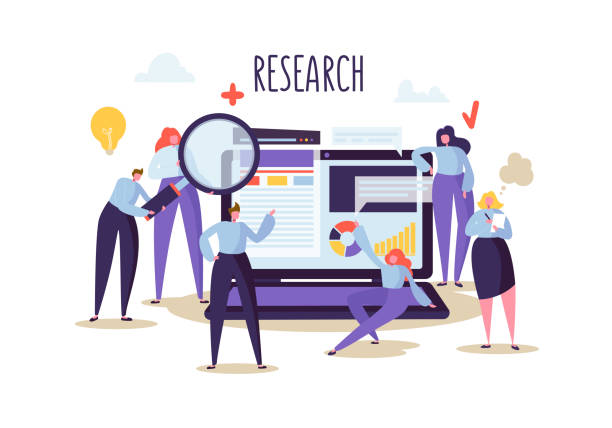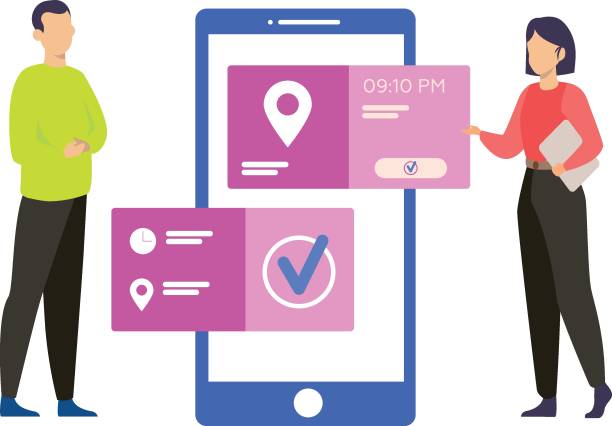The Importance of Multilingual Website Design in the Age of Globalization

In today’s world, where geographical borders are rapidly fading, entering global markets is no longer an option, but a necessity.
#Globalization #Target_Market #Communications.
One of the most powerful tools to achieve this goal is multilingual website design.
This approach enables businesses to communicate with their audience worldwide in their native language, which not only improves user experience but also fosters a sense of trust and closeness.
As an explanatory and educational tool, a multilingual website can provide information about your products and services to a wide range of potential customers without language barriers.
This is particularly vital for companies looking to export or expand their operations into other countries.
Imagine your website being available in only one language; this means you are missing out on a huge portion of the global population.
In contrast, a website with language-switching capability opens new doors for you and provides countless opportunities for growth.
This strategy is the cornerstone of effective international presence and an important step towards becoming a global brand.
Understanding this principle is the first step towards planning a successful multilingual website design.
Tired of losing customers due to poor e-commerce website design? With Rasawweb, solve this problem forever!
✅ Increase sales and visitor-to-customer conversion rates
✅ Smooth and engaging user experience for your customers⚡ Get free consultation
Competitive Advantages of an International Website for Businesses

Having a multilingual website goes beyond mere content translation; it is a strategic competitive advantage.
With multilingual website design, businesses can expand their reach to new markets and grow their customer base beyond their current geographical and cultural boundaries.
This leads to increased sales and revenue, as you gain the ability to attract customers who were previously unable to access your products or services due to language barriers.
Furthermore, a multilingual website enhances your brand’s credibility and professionalism on an international level.
When a visitor from another country can find the information they need in their native language, their sense of trust and satisfaction significantly increases.
This positive feeling directly impacts conversion rates and customer loyalty.
This approach demonstrates deep analytical insight into international customer behavior, allowing you to optimize your marketing strategies with more accurate data.
Additionally, multilingual SEO helps you achieve higher rankings in local search engines and attract more organic traffic.
This investment not only reduces marketing costs but also ensures greater long-term returns.
Key Technical Considerations in Implementing Multilingual Website Design

Multilingual website design technically requires precision and meticulous planning.
Choosing the appropriate URL structure (such as country code top-level domains (ccTLDs), subdomains, or subdirectories) is crucial for international SEO.
Each of these options has its own advantages and disadvantages that must be selected to suit your business goals.
For instance, ccTLDs have high local credibility but are more complex to manage, while subdirectories are simpler but might be less recognized by Google as truly local content.
Furthermore, using hreflang tags in the HTML code of each page to indicate the appropriate language and region version of that page to search engines is mandatory.
These tags prevent duplicate content issues and help improve rankings.
Choosing a Content Management System (CMS) that natively supports multilingual capabilities or provides this functionality through plugins and modules is also of high importance.
The CMS should make the translation and content management process simple and efficient.
These specialized and guiding aspects are the cornerstone of a stable and scalable multilingual website.
Ignoring any of these can lead to serious problems in website visibility in search results and user experience.
Optimizing images for each language and ensuring website compatibility with fonts and reading direction (such as RTL for Persian and LTR for English) are also other important technical considerations.
| Technical Aspect | Description | Importance |
|---|---|---|
| URL Structure | Choice between ccTLD, Subdomain, Subdirectory | Crucial for SEO and Local Credibility |
| Hreflang Tag | Indicates specific language and region version of each page | Mandatory to prevent duplicate content and improve SEO |
| CMS Support | Native multilingual content management system or via plugin | Essential for easy content management and translation |
| Text Direction (RTL/LTR) | Compatibility with Right-to-Left and Left-to-Right languages | Important for Native User Experience |
Search Engine Optimization (SEO) for Multilingual Content

SEO for multilingual website design is one of the most complex yet crucial aspects.
Simply translating keywords is not enough; you must conduct keyword research separately for each language and target market.
Keywords that are successful in one language may have a different meaning or not be used at all in another language.
Furthermore, user intent can vary across different cultures, requiring the production of content tailored to it.
Technical SEO also plays an important role; as mentioned in the previous section, correct implementation of hreflang tags helps search engines show the correct version of each page to users in the appropriate language and region.
This is a specialized point that, if not adhered to, can lead to a drop in ranking.
Additionally, building internal and external links tailored to each language and market is of great importance.
Links should be from reputable and relevant websites in the same language and region.
High-quality, localized content, which is not just a translation but also aligns with local culture and dialect, is among the key factors for successful multilingual SEO.
This comprehensive approach ensures that your website is understandable and optimized not only for users but also for search engine crawlers, thereby attracting targeted organic traffic for each language version.
Tired of losing customers due to poor e-commerce website design? With Rasawweb, solve this problem forever!
✅ Increase sales and visitor-to-customer conversion rates
✅ Smooth and engaging user experience for your customers⚡ Get free consultation
Content and Translation Management in Multilingual Platforms

One of the biggest challenges in multilingual website design is efficient content and translation process management.
This section of the article is educational and guiding.
Translation is not merely a linguistic conversion; it requires localization.
Localization includes adapting content to cultural differences, local idioms, currencies, date and time formats, and even colors and images.
For this purpose, using Translation Management Systems (TMS) or internal multilingual capabilities within a CMS can facilitate this process.
These systems allow you to manage original content in one place and store and update translated versions in an organized manner.
Also, creating a dedicated Glossary and Translation Memory is very useful for ensuring the consistency and quality of translations over time.
Collaborating with native translators and specialists in your field is key to producing high-quality and engaging content for each market.
They not only know the language but are also familiar with cultural and social nuances, which is vital for attracting an audience.
This process should be an integral part of your multilingual platform’s long-term strategy, not a one-time action.
Continuous content updates in all languages are also essential to maintain website credibility and ranking.
This section guarantees the quality and sustainability of your international presence.
What is User Experience (UX) in Multilingual Website Design?

User Experience (UX) in multilingual website design is just as important as in a single-language website.
In fact, one could say its importance is even greater, as you are dealing with cultural diversity and varying user expectations.
A good multilingual website should make the option to change language easily and clearly accessible to the user, typically via a button or dropdown menu at the top of the page.
This small element has a big impact on ease of use and user satisfaction.
Furthermore, the design must support various languages; this includes text direction (RTL for Persian, Arabic, and Hebrew; LTR for most European languages), font sizes, and even how images and icons are displayed.
An entertaining and engaging user experience can be created through localized content that aligns with local humor, examples, and cultural references.
Although this is an explanatory point, its practical importance is very high.
Page loading speed worldwide, optimized images and videos for slower networks in some regions, and compatibility with various devices (mobile, tablet, desktop) are also part of multilingual UX.
The ultimate goal is for the user, regardless of their language, to feel that the website has been designed for them and their needs.
This approach helps multilingual website design not only attract new users but also convert them into loyal customers.
Common Challenges and Solutions in Developing Multilingual Websites

Multilingual website design comes with unique challenges that must be addressed.
One of the main problems is maintaining content consistency and quality across all languages.
Machine translation, though fast, often lacks accuracy, cultural nuances, and appropriate tone, which can damage the brand image.
The solution is to use professional translators and localizers for challenging and specialized content.
Another challenge is the complexity of international SEO; managing hreflang tags, URL structure, and keyword research for each language requires high technical knowledge and continuous updates.
To overcome this problem, collaboration with international SEO specialists is a necessity.
Technical issues such as supporting special characters, fonts, and text direction (RTL/LTR) can also be challenging, which can be resolved by choosing an appropriate CMS and flexible design.
Additionally, managing costs and scheduling for translating and updating content in multiple languages can be heavy.
This requires a long-term strategy and the use of translation management tools.
| Challenge | Description | Solution |
|---|---|---|
| Translation Quality | Machine translation lacks accuracy and cultural nuance | Use of professional translators and localizers |
| International SEO | Complexity of hreflang tags and keyword research | Collaboration with international SEO specialists |
| Technical Management | Support for characters, fonts, RTL/LTR | Choosing appropriate CMS and flexible design |
| Cost and Time | High cost of translation and continuous updates | Long-term strategy and use of TMS |
With careful planning and the use of specialized guidance, these obstacles can be overcome, and a successful multilingual website can be achieved.
Choosing the Right Tools and Platform for Multilingual Website Design

Choosing the right tools and platform is one of the most important decisions in the multilingual website design process.
This decision should be made based on your business’s needs, budget, and long-term goals.
Content Management Systems (CMS) such as WordPress (with plugins like WPML or Polylang), Drupal, and Joomla are popular choices that offer multilingual support through their plugins or native capabilities.
WordPress, due to its ease of use and vast plugin ecosystem, is suitable for many small and medium-sized businesses, while Drupal is considered a better option for larger and more complex projects with high customization needs.
E-commerce platforms like Shopify and Magento also have plugins and functionalities for multilingual stores.
In addition to CMS, Translation Management Systems (TMS) also play a key role.
These tools help organize and automate the translation process, ensuring consistency of terminology and quality of translations.
Some TMS tools can directly connect to the CMS, which greatly simplifies the content update process.
The selection of these tools should be based on a specialized analysis of the needs of the translation team and content managers.
For larger projects, it may be necessary to develop custom solutions or use dedicated platforms.
Ultimately, it is important to choose a platform that has the necessary scalability for future growth and flexibility to adapt to changing market needs.
This section is a comprehensive guide for informed decision-making.
Did you know that 94% of users’ first impressions of a business are related to its website design? With professional corporate website design by **Rasawweb**, turn this first impression into an opportunity for growth.
✅ Attract more customers and increase sales
✅ Build credibility and trust in the audience’s view⚡ Get free website design consultation!
Successful Examples and Lessons Learned from Multilingual Websites

Reviewing successful examples of multilingual website design can be inspiring and educational.
Companies like Airbnb and IKEA are prominent examples of multilingual websites that have successfully connected with their global audiences.
Airbnb provides a personalized experience to its users worldwide by offering localized content for various destinations.
This includes not only language translation but also cultural information, region-specific images, and even local payment options.
IKEA has also become a popular global brand by providing its product catalogs in various languages and adapting them to local cultures.
Lessons learned from these examples show that success in multilingual website design is not limited to text translation.
Deep localization, attention to cultural details, and providing a consistent and optimized user experience across all languages, are key.
This requires accurate analysis of the target market and investment in high-quality, relevant content.
Additionally, regular updates and monitoring of SEO performance in each language are also of high importance.
This section covers news and analytical aspects and demonstrates how leading companies have used this opportunity to expand their global reach.
Inspired by these cases, more effective strategies can be developed for your international website.
The Future of Multilingual Website Design and Emerging Trends

The future of multilingual website design is full of emerging trends and advanced technologies that will make user experience even more personalized and efficient.
One of the most important trends is the use of Artificial Intelligence (AI) and Machine Learning (ML) in the translation and localization process.
These technologies can increase translation speed and improve its accuracy; although they do not fully replace human translators yet, they provide powerful tools to assist them.
The questionable content in this area is whether AI can fully understand cultural nuances and provide perfectly localized translations? The answer is likely no, but it serves as a very powerful start.
Advanced personalization based on the user’s geographical location and language preferences, even before the user selects a language, is another trend that helps improve UX.
This becomes even more important with the increasing use of mobile devices and Voice Search, which require local content and accurate answers to local questions.
Virtual Reality (VR) and Augmented Reality (AR) may also play an important role in delivering multilingual content in the future, especially in areas like education and tourism.
Big Data analysis to deeply understand user behavior in different cultures and continuously optimize multilingual website design will also be highly important.
These developments point to a future where international websites will be increasingly intelligent, localized, and accessible to everyone.
Frequently Asked Questions
| Question | Answer |
|---|---|
| What is a multilingual website? | A website whose content is available to users in more than one language. |
| Why should I make my website multilingual? | To reach a larger audience in global markets, improve user experience, and enhance international SEO. |
| What are the technical approaches to building a multilingual website? | Using subdirectories, subdomains, or URL parameters to differentiate languages. |
| How does multilingual design affect SEO? | By targeting local keywords and providing content in users’ native languages, the site’s ranking in search engines for those regions improves. |
| What are the challenges of multilingual website design? | Content translation management, Right-to-Left (RTL) direction support, technical issues related to language addressing, and maintaining design consistency. |
| How do we choose the languages for a multilingual site? | Based on target audience analysis, desired markets, and current website traffic data (if available). |
| What is RTL support and why is it important for some languages? | Right-to-Left is the direction of text and page elements display from right to left, which is essential for languages like Persian, Arabic, and Hebrew. |
| How to manage multilingual website content? | Using Content Management Systems (CMS) with multilingual capabilities, translation plugins, or professional translation services. |
| How is User Experience (UX) in a multilingual website? | The ability to easily change languages should be provided, and the translated content should be of high quality so that users feel comfortable. |
| What are the common CMS platforms for multilingual websites? | WordPress (with plugins like WPML), Joomla, Drupal, and Shopify (with relevant settings or plugins). |
And other services of Rasawweb Advertising Agency in the field of advertising
The role of customer support in the success of advertorials
How to use advertorials to introduce new medical technologies
Leveraging analytical tools to measure advertorial performance
The role of landing pages in converting advertorial readers into customers
How to use advertorials for inexpensive medical products
And over hundreds of other services in the field of online advertising, advertising consulting, and organizational solutions
Online Advertising | Advertising Strategy | Advertorials
🚀 Revolutionize your business’s digital transformation with Rasawweb’s online advertising and advertorial strategies.
📍 Tehran, Mirdamad Street, next to Bank Markazi, Southern Kazeroon Alley, Ramin Alley, No. 6

